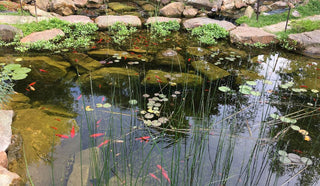All gardeners want to be green — except when it comes to water.
Whether you have a fountain, pond or a small reflecting pool, chances are good that at some point you'll have to deal with nuisance algae.
Mother Nature has a way of colonizing just about any watery habitat with algae — even a birdbath. Small amounts of algae may be a simple annoyance, discoloring containers with a film of green slime. In ponds, however, large amounts of algae can clog pumps and filters and harm fish.
The best method for reducing algae growth depends on the size and type of the water feature, the time of year and the extent of the problem, as well as aesthetics and convenience. To keep ponds clear, it's best to begin treatment early in the season before problems arise.
Bird Baths and Small Fountains
Bird Bath Cleaners keep your bird bath fresh and crystal clear the way nature does, with the cleansing power of beneficial bacteria and enzymes. One disposable dispenser of our all-natural cleaner works for 30 days and cleanses containers up to 7 gallons.
Container Water Gardens and Small Ponds
Submersible dispensers treat 300 to 2,500 gallons for 30 days, ideal for small ponds. Using beneficial bacteria and enzymes to clarify water, this discreet plastic dispenser can be submerged in your pond; refills are available.
Large Ponds
Ideally, large ponds contain a variety of plant and animal life that can help keep algae in check, but you might need to take steps to prevent murky water. Here are some helpful products:
The Aquasphere float is a biodegradable ball in your pond that will keep algae in check for 30 days.
It is made from 100 percent biodegradable cornstarch that slowly degrades and dissolves. It contains beneficial bacteria and enzymes that reduce excess nutrients that lead to algae blooms. For best results, install a fresh Aquasphere monthly.
Blast is a quick and effective way to deal with algae blooms, which are algae overgrowths that can occur during certain weather conditions. This product is best used along with the Aquasphere for long-lasting protection. It's concentrated source of beneficial bacteria similar to those found in the Aquasphere. It is best used to manage seasonal spikes in algae growth; use it alongside the Aquasphere for long-term control. Available in two formulations, based on pond size: 2,500-gallon and 125,000-gallon.
Pond Care Tips
- Calculating capacities: A small fountain generally has a reservoir that holds 10 gallons or less. A container garden the size of a half whiskey barrel holds about 30 gallons. To calculate the approximate number of gallons in your pond, start by calculating the cubic feet: multiply length (in feet) x width x average depth. To convert cubic feet to gallons, multiply by 7.5.
- For information on designing a water garden, including ways to create a balanced ecosystem that will help prevent algae overgrowth, read Water Gardening: Finding the Site, Choosing Plants and Fish


 Submersible Dispenser
Submersible Dispenser Aquasphere
Aquasphere

